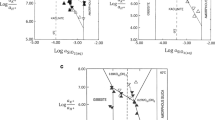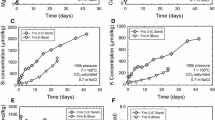Abstract
Chemical activity diagrarns, prepared to illustrate the properties expected if mixed-layer mont-morillonite/illite is regarded as a solid solution, are compared to those derived from a treatment of these materials as a mixture of two phases. If the system is a solid solution, the coexisting aqueous solution should range from higher dissolved silica contents in the presence of kaolinite and a montmorillonite end member to lower dissolved silica in the presence of kaolinite and an illitic end member. Silica concentration in the aqueous solution might vary by a factor of as much as six. If the system is two phase, the silica content of a solution in equilibrium with kaolinite and both phases would be fixed at a given T and P, as would a solution equilibrated with both phases and K-feldspar. In the absence of a third phase, silica in equilibrium with both phases should be nearly constant, but increase with increasing ratio of K+/H+ in solution. Available data on coexisting aqueous solutions apparently are more nearly consistent with two phases than with a solid solution.
Резюме
Диаграммы химической активности, подготовленные для показания ожидаемых свойств в случае, когда смешано-слойный монтмориллонит/иллит считается как твердый раствор, сравнивались с диаграммами полученными для этих материалов, рассматриваемых как смесь двух фаз. Если эта система рассматривается как твердый раствор, ожидается, что сосуществующий водный раствор имеет большие содержания растворенного кремнезема в присутствии каолинита и монтморилло-нитового конечного члена и меньшие содержания в присутствии каолинита и иллитового конечного члена. Концентрация кремнезема в водных растворах может изменяться даже в шесть раз. Если эта система рассматривается как смесь двух фаз, тогда содержание кремнезема в растворе в состоянии равновесия с каолинитом и двумя фазами будет неизменяющимся при данных температуре и давлении, так как раствор в равновесии с двумя фазами и К-фельдшпатом. В отсутствии третьей фазы, содержание кремнезема в равновесии с двумя фазами будет почти постоянное, но увеличивается с увеличением отношения К+/Н+ в растворе. Доступные данные по сосуществующим водным pacrl ворам, по-видимому, являются более согласующимися в случае двух фаз, чем в случае твердого раствора. [E.G.]
Resümee
Chemische Aktivitätsdiagramme, die hergestellt wurden, um die Eigenschaften, die man erwartet, wenn man Montmorillonit/Illit-Wechsellagerungen als feste Lösungen betrachtet, zu beschreiben, werden mit denen vergleichen, die man erhält, wenn man diese Substanzen als eine Mischung aus zwei Phasen behandelt. Wenn das System eine feste Lösung ist, dann sollte die koexistierende wässrige Lösung von höheren gelösten SiO2-Gehalten in der Gegenwart von Kaolinit und einem Montmorillonit-Endglied bis zu niedrigeren gelösten SiO2-Gehalten in der Gegenwart von Kaolinit und einem illitischen Endglied reichen. Die SiO2-Konzentration in der wässrigen Lösung kann bis zu einem Faktor von sechs variieren. Wenn das System als aus zwei Phasen bestehend betrachtet wird, dann wäre der SiO2-Gehalt einer Lösung im Gleichgewicht mit Kaolinit, und beide Phasen wären bei einem gegebenen T und P fixiert, wie auch eine Lösung mit beiden Phasen und K-Feldspat ins Gleichgewicht gebracht wäre. In Abwesenheit einer dritten Phase sollte das SiO2, das im Gleichgewicht mit beiden Phasen ist, nahezu konstant sein, aber mit wachsendem K+/H+-Verhältnis in der Lösung ansteigen. Die zur Verfügung stehenden Daten über koexistierende wässrige Lösungen stimmen offensichtlich eher mit der Annahme von zwei Phasen als mit der Annahme einer festen Lösung überein. [U.W.]
Résumé
Des diagrammes d’activité chimique, préparés pour illustrer les propriétés attendues si une montmorillonite/illite à couches mélangées est considérée comme une solution solide, sont comparés à ceux dérivés d’un traitement de ces matériaux en tant que mélange de deux phases. Si le système est une solution solide, la solution aqueuse coexistante devrait s’étager de contenus en silice dissoute plus élevés en la présence de kaolinite et d’un membre final de montmorillonite, à des contenus en silice dissoute moins élevés en présence de kaolinite et de l’illite comme membre final. La concentration en silice dans la solution aqueuse peut varier d’un facteur aussi élevé que six. Si le système est à deux phases, le contenu en silice d’une solution en équilibre avec la kaolinite et les deux phases serait fixé à des T et P données, comme le serait une solution équilibrée avec les deux phases et du feldspar-K. En l’absence d’une troisième phase, la silice en équilibre avec les deux phases devrait être presque constante, mais devrait augmenter proportionnellement à la proportion croissante de K+/H+ en solution. Les données sur les solutions coexistantes sont apparemment plus consistantes avec deux phases qu’avec une solution solide. [D.J.]
Similar content being viewed by others
References
Aagaard, P. and Helgeson, H. C. (1983) Activity/composition relations among silicates and aqueous solutions II. Chemical and thermodynamic consequences of ideal mixing of atoms among energetically equivalent sites in mont-morillonites, illites, and mixed layer clays: Clays & Clay Minerals 31, 207–217.
Garrels, R. M. and Tardy, Y. (1982) Born-Haber cycles for interlayer cations of micas: in Proc. 7 th Int. Clay Conf., Bologna and Pavia, 1981, H. Van Olphen and F. Veniale, eds., Elsevier, Amsterdam, 423–440.
Helgeson, H. C. and Mackenzie, F. T. (1970) Silicate-sea-water equilibria in the ocean system: Deep-Sea Research 17, 877–892.
Hower, J., Eslinger, E. V., Hower, M. E., and Perry, E. A. (1976) Mechanism of burial metamorphism of argillaceous sediment: mineralogical and chemical evidence: Geol. Soc. Amer. Bull. 87, 725–737.
Hower, J. and Mowatt, T. S. (1966) The mineralogy of illites and mixed-layer illite/montmorillonites: Amer. Mineral. 51, 825–854.
Inoue, A., Minato, H., and Utada, M. (1978) Mineralogical properties and occurrence of illite/montmorillonite mixed layer minerals formed from Miocene volcanic glass in Waga-Omono District: Clay Science 5, 123–136.
Korzhinski, D. S. (1959) Physiochemical Basis for the Analysis of the Paragenesis of Minerals: English translation, Consultants Bureau, New York, 142 pp.
Perry, E. and Hower, J. (1970) Burial diagenesis in Gulf Coast pelitic sediments: Clays & Clay Minerals 18, 165–177.
Robie, R. A., Hemingway, B. S., and Fisher, J. R. (1978) Thermodynamic properties of minerals and related substances at 298. 15K and 1 bar (105 pascals) pressure and at higher temperatures: U.S. Geol. Sun. Bull. 1452, 456 pp.
Tardy, Y. and Fritz, B. (1981) An ideal solid solution model for calculating solubility of clay minerals: Clay Miner. 16, 361–373.
Zen, E-An (1962) Problem of the thermodynamic status of the mixed-layer minerals: Geochim. Cosmochim. Acta 26, 1055–1067.
Author information
Authors and Affiliations
Rights and permissions
About this article
Cite this article
Garrels, R.M. Montmorillonite/Illite Stability Diagrams. Clays Clay Miner. 32, 161–166 (1984). https://doi.org/10.1346/CCMN.1984.0320301
Received:
Accepted:
Published:
Issue Date:
DOI: https://doi.org/10.1346/CCMN.1984.0320301




